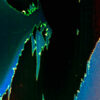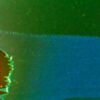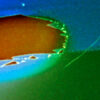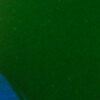I cannot tell you the names of the rivers that I speak of. Their mussel beds are now so rare that few people beyond those that study them are permitted to know of their existence at all.
The freshwater pearl mussel has a life that is longer than our own. In Britain and Ireland they live up to 120 years; in latitudes closer to the Arctic, in Finland or in Norway, up to 300. Individual specimens have been around since the invention of the steam engine. One can count their growth lines, much like tree rings, beneath a microscope. They have been on this planet for 120 million years, and they came to British and Irish waters at the end of the last ice age. ‘You fall in love with them,’ Evelyn Moorkens, who has devoted decades to their research, confides in me. ‘I have given my life to them.’
Male mussels release sperm through their siphons. Female mussels inhale the sperm and retain the fertilised eggs within their bodies, incubating them, each female with up to 4 million larvae clinging to her gills. By late summer the female mussel can no longer breathe for offspring. She releases them through her own siphon into the river’s flow. But for a sedentary species to hold their position in a fast-flowing river demands a plan. If not, over the millennia they would ultimately be swept into the ocean, even if only by a few metres’ drift each generation. The plan they have is salmon.
Juvenile salmon, hatched in the same pools that the mussels inhabit, inhale the larvae as they pass. There they remain, encysted on the fishes’ gills until the end of the following spring. They do not harm the salmon. Some studies suggest that they confer a benefit, that the antibodies the salmon develop when the larvae attach protect them from the sea lice and other parasites that they may acquire during their lives. Before the salmon depart for the oceans, the mussels, now grown large enough, detach from their hosts and burrow down into the river’s bed. In five years they return to the surface, where they remain for the next century or so.
When they were abundant, pearl fishers would decimate mussel beds, ripping shells apart in search of the occasional gem. That has long since been made illegal, but agriculture, the draining of the bogs surrounding rivers and the silting up of riverbeds all continue to decimate stocks. Like salmon, mussels require their environment pristine. They filter their own water, but they cannot keep up with modern practices. Their young are dying, their populations ageing. They need only breed twice in a hundred years, but even that is a challenge these days.
And then there are the salmon, as integral to the mussels’ life cycle as the mussels are themselves. Wild salmon in Ireland are at their lowest levels since records began. Once, 30 per cent of adult salmon returned to the rivers of their birth to spawn; today it is more like 3 per cent. The story is the same in Scotland. That country’s last commercial operation, a single man netting on the River Esk, was shut down in 2018. Salmon runs in England and Wales hover on the verge of extinction. If the salmon go, so do the mussels.
For now, they cling on.
I hear of Nigel Mott on the news one morning. A fisherman, one of the last commercial fishermen of wild salmon on the River Severn, has won a landmark case against the Environment Agency (EA). For several years I have been travelling in Alaska, documenting the decline of salmon and Indigenous salmon fishing there, and there are strong echoes with the court cases I have been following on the Yukon River, 4,000 miles away. I give him a call.
Nigel collects me from the coach station in Bristol. His car is full of rope and bits of beehive. We leave the city, cross the Severn and drive up the north bank of the river towards Lydney. At the edge of town he pulls off the road and steps out to unlock a five-bar gate. Nigel is in his mid-seventies, his hair thin and grey, and he walks stiffly, bent forward at the waist, but he has a tough energy to him, thick arms, a life carved from hard work. We head across rutted fields, lurching, much faster than I would drive them, but this was Nigel’s commute for more than forty years, and besides, we are chasing the tide. We run parallel to an embankment, and then we crest the rise and plough through an ungrazed field and Nigel brings the car to a sudden stop.
We get out. The song of skylarks. And before us, stretching away, is the Severn. I am accustomed to seeing it from the bridge, but from here it is shocking and vast, at least a mile, maybe two, from bank to bank. In the near distance, the first of the bridges; behind it, further, the other. The sky is grey, the river brown, and flowing on the tide at quite a pace. The wind is cold. Across the water one of the world’s first commercial nuclear power stations, Berkeley, now decommissioned, sits solid in the gloom.
Piles of discarded putcher baskets are abandoned on the bank like the remains of shopping trolleys, in the weeds of the shoreline and on the rocks that prop the shore up and which prevent the banks from sloughing away into the mud. Nigel built his putchers from stainless steel – once they were woven from two-year-old willow – and they won’t be going anywhere any time soon. Quite possibly they will outlast the salmon. Some of the fish weir remains as well, long timbers of larch stretching out from the bank, crosswise to the river’s flow, now slumped at angles and beyond any sense of repair. The putchers, each of them longer than a person, would have been stacked in the weir, four tiers of them, pushing out over a hundred metres into the river. Six-hundred-and-fifty baskets. Six-hundred welds on each one. There is evidence here of fishing weirs that goes back several centuries at least, though it is likely they have existed for millennia. The Severn has the third-highest tide in the world, at thirty-one and a half feet, and for sloshing salmon through baskets you could hope to find nowhere better; nowhere else caught fish like this. Sited in the swiftest channel, their wide mouths pointing upriver and funnelling to a point, the four ranks of baskets would be set on a low tide at the beginning of the season and entirely covered by the river on each high. The salmon would be caught on the ebb of the tide and trapped as they flowed downstream, unable to turn back against the force of the river. ‘Like a pig in a passage,’ Nigel says.
The season ran from 16 April to 16 August. He and his partner checked and cleaned the baskets twice a day, sharing the work two tides on, two tides off. Crows followed the ebb tide so you had to get to the fish quick, before they plucked the eyes out. There were perhaps ten operations on this stretch. Everyone knew everyone. Nigel had a twenty-year lease here, and a permit for 600 salmon in the season. That made £60,000 or so, shared between the two of them. But things had been getting tougher for some time.
‘The summer of 1990 was the best season we ever had,’ he says. ‘The river was absolutely stuffed with fish. And we haven’t had a decent season since.’ Numbers had been dwindling for years, but around 2000 they collapsed. In 2010, to protect the run on the Wye, the EA halted fishing. Nigel argued that the mouth to the Wye was downstream of their operation, and that a few small-time fishermen could not be responsible for the collapse of the Wye’s run. In 2012 the fishing was reopened and the EA issued them with new permits – for thirty salmon in a season. ‘I might have gone on in a minor capacity for quite a number of years,’ says Nigel. But with the catch limit set so low there was no living to be made, and no sense in carrying on.
A man passes us, walking his dog. They know each other, in the easy way that people out here do, no real surprise to find each other on a forgotten piece of riverbank. Nigel greets him, though not by name.
‘Does it bring back memories?’ the man asks, gesturing to the putchers.
Nigel waves the memories away. ‘Best not think about it,’ he says.
The man nods. He whistles his dog and walks on.
Nigel pulls two lave nets from out the boot of the car. If there was a method of fishing more ancient, more basic, than the putchers, then I am looking at it. Such nets do not come from tackle shops; Nigel makes them himself. Three poles of wood of similar length, each six feet long, one a handle, the other two hinging open into a V, held apart by a chock of wood, and a handmade net strung between them, so that the whole apparatus is like a vast shovel. The handle of Nigel’s net is ash, the rimes hazel, although black willow, he says, is best. The crosspiece is elm, a piece of wood which has still not settled and found its shape in the fifty years since he fitted it. In this it is like the river, with its sandbars skulking about beneath the surface, its banks forever on the move. Plenty of ships have run aground through here. It is a good net, it has served him well. But there’s no point in a good net, he mutters, if there are no fish to catch. Nigel’s £60 lave licence permits him to catch a single salmon in a season. One.
We pick our way down the sludge of the bank, leaning heavily on the nets. Lean forward, weight on the toes, keep moving, or the mud begins to suck you downward. At any moment I expect Nigel to tell me that all this is a joke, the very gullibility of what a city boy will believe of country life. But then we are in the shallows, the water up to our thighs, and with a warning not to drift too far downriver or I’ll be heading out to sea, Nigel sinks onto his front, his head directed downstream, and holding the net before him as a float he sculls out into the channel. I watch him go, and then I follow.
The water is warmer than I expected. We move along at quite a pace. I watch Nigel ahead of me, ferrying out into the middle of the river. It makes me think of otters. For a time I drift on my back and watch the sky. If I pull level with Nigel we can chat. Without him here this would feel insane. Plenty of folk have drowned in these waters, not least those who used to work the putchers. In his forty years of fishing Nigel has learned the Severn’s ways and moods, although he insists only across this stretch. Take him a few miles upriver, he says, and he’d be lost. We are nearing the bridge, angling directly for the middle of the estuary now, and up ahead the water has a subtly different quality to it, with small riffles upon its surface, and it is for here that Nigel points his net.
Suddenly he stands, and wades downstream, emerging from the river. By the time I reach him he is standing with the water around his thighs, his net unfurled, and I stand up beside him. The bridge, the older of the two, is almost directly above us. The tide whipping around its enormous stanchions. I can make out people in the cars, and from up there we must look biblical. Two miles of water, and two men with ancient instruments balanced in the centre upon its surface.
The way it works is this. We are on the outgoing tide, and salmon, guided by deep-flowing channels, will be pushed towards the sandbar we are walking. When they realise they are running out of river they will turn and swim back upstream, and where they force against the river’s flow their wake, or loom, will give them away. At that point we’ll hustle over and scoop them up. In comparison with the delicacy of fly fishing, this feels like the use of a blunt instrument. But it is effective. Not so long ago there was a six-man team operating lave nets out of Lydney, making a living. Those days are gone. Yet as we make our way upriver it is increasingly clear that the catching of the fish itself is not really the point. The point is to find a reason still to be here.
The Court of Appeal upheld the EA’s decision to curtail Nigel’s permit on grounds of sustainability. They found that the 10,000 to 15,000 salmon that enter the Wye each year needed all the help they could get. But the court also found that the EA had given no consideration to the impact on Nigel’s life and livelihood, and that his human rights had been breached. Nigel fought the case up to the Supreme Court, where the judge ordered the EA to pay him £187, 278 for loss of earnings for the years 2012–14. He is now chasing payment for lost earnings from 2015 up to the present day. So far, the proceedings have cost £400,000. It is, he says, a strain on the finances. But I can see that he gets a great satisfaction from taking on these powers.
‘What happened to the fish?’ I ask.
‘The salmon are in trouble in the whole North Atlantic,’ he says over the river and the outrushing tide. ‘Our rivers, on the whole, are cleaner than they’ve been in a long time. It’s very hard to understand why the salmon are in such decline if it’s not for something new, like salmon farming.’ There are no salmon farms this far south: most are concentrated off the west coasts of Scotland and Ireland. Sea lice occur naturally in the wild, but in the confined spaces of a fish farm, where a single cage can house 70,000 salmon, they thrive. It does not take many lice to kill a young salmon. The detrimental impact caused by lice from these salmon farms, when they transfer to wild stocks leaving Scottish and Irish rivers, has been well documented, but Nigel believes that on their migration routes north the Severn’s salmon are also becoming infested.
‘I don’t resent the fact that they farm fish,’ says Nigel. ‘I don’t even resent that there’s side effects. What I really resent is that they won’t admit there’s side effects.’ A new business with better prices, pushing out an old business, he says, is simply the way of the world. But he believes the EA has unfairly targeted commercial fishermen for the declines, and has not been transparent about the damage done by salmon farms. ‘If other people suffer as a result, in a perfect world, you would pay compensation. You would use some of that success to compensate those who have suffered. And they have done exactly the opposite. They have persecuted us.’ Nigel trots to the far side of the shoal where a wake is breaking the surface, but it is only a submerged branch.
We walk for the rest of the afternoon, making our way along the sandbar. We see no salmon. It means, at least, that he can come back another day. After some hours we draw level with the car. Nigel shoulders his net. The sandbar is almost exposed now, the river round our ankles. There is one deep channel we must swim across to get back to the bank. I am beginning to wade in, balancing with my net, when Nigel pauses, looking back. ‘I can never resist turning round for one last look,’ he says. ‘In case one’s got stuck on the shoal.’
The following year, the lave net licence is reduced from a single fish to zero.
Alaska is one place that is still renowned for salmon. The grizzly standing in the torrent, plucking salmon from the flow. It supports a multimillion-dollar wild-fishing industry, is on every angler’s bucket list. Its Indigenous populations harvest salmon for their subsistence every summer, smoking and drying them in fish camps along the banks. The fish are said to run so thick up some rivers that those on the outside are forced onto the banks. Bristol Bay, on Alaska’s western coast, is home to the world’s largest salmon run and is its most important fishery, providing 75 per cent of local jobs and in 2019 generating over $300 million from salmon alone. But Alaska is iconic because it is the only place like this that’s left.Europe once had the greatest density of salmon rivers in the world. In Anglo-Saxon times, rent was sometimes paid in salmon. Daniel Defoe, on a walkabout of Scotland, wrote in 1724 of ‘salmon in such plenty as is scarce credible’. At the beginning of the nineteenth century, the salmon sold in Billingsgate were taken in the Thames. Yet the last salmon in London was caught in 1833. Today it is extinct from most European rivers, including the River Salm in Germany, after which the salmon is said to be named.


Sign in to Granta.com.








